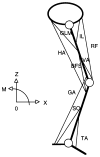Optimization-based models of muscle coordination
- PMID: 11800497
- PMCID: PMC2821033
- DOI: 10.1097/00003677-200201000-00007
Optimization-based models of muscle coordination
Abstract
Optimization-based models may provide reasonably accurate estimates of activation and force patterns of individual muscles in selected well-learned tasks with submaximal efforts. Such optimization criteria as minimum energy expenditure, minimum muscle fatigue, and minimum sense of effort seem most promising.
Figures




Similar articles
-
Muscle coordination of movement: a perspective.J Biomech. 1993;26 Suppl 1:109-24. doi: 10.1016/0021-9290(93)90083-q. J Biomech. 1993. PMID: 8505346 Review.
-
Muscles within muscles: Coordination of 19 muscle segments within three shoulder muscles during isometric motor tasks.J Electromyogr Kinesiol. 2007 Feb;17(1):57-73. doi: 10.1016/j.jelekin.2005.10.007. Epub 2006 Feb 2. J Electromyogr Kinesiol. 2007. PMID: 16458022
-
Coordination of two- and one-joint muscles: functional consequences and implications for motor control.Motor Control. 2000 Jan;4(1):1-44. doi: 10.1123/mcj.4.1.1. Motor Control. 2000. PMID: 10675807 Review.
-
Understanding muscle coordination of the human leg with dynamical simulations.J Biomech. 2002 Aug;35(8):1011-8. doi: 10.1016/s0021-9290(02)00046-5. J Biomech. 2002. PMID: 12126660
-
Interplay of biomechanical and neuromuscular constraints on pattern stability and attentional demands in a bimanual coordination task in human subjects.Neurosci Lett. 2001 May 4;303(2):127-31. doi: 10.1016/s0304-3940(01)01650-0. Neurosci Lett. 2001. PMID: 11311509
Cited by
-
Forces and moments generated by the human arm: variability and control.Exp Brain Res. 2012 Nov;223(2):159-75. doi: 10.1007/s00221-012-3235-0. Epub 2012 Sep 28. Exp Brain Res. 2012. PMID: 23080084 Free PMC article.
-
Optimality versus variability: effect of fatigue in multi-finger redundant tasks.Exp Brain Res. 2012 Feb;216(4):591-607. doi: 10.1007/s00221-011-2963-x. Epub 2011 Dec 1. Exp Brain Res. 2012. PMID: 22130781 Free PMC article.
-
Computing reaching dynamics in motor cortex with Cartesian spatial coordinates.J Neurophysiol. 2013 Feb;109(4):1182-201. doi: 10.1152/jn.00279.2012. Epub 2012 Oct 31. J Neurophysiol. 2013. PMID: 23114209 Free PMC article.
-
Musculotendon Parameters in Lower Limb Models: Simplifications, Uncertainties, and Muscle Force Estimation Sensitivity.Ann Biomed Eng. 2023 Jun;51(6):1147-1164. doi: 10.1007/s10439-023-03166-5. Epub 2023 Mar 13. Ann Biomed Eng. 2023. PMID: 36913088 Free PMC article. Review.
-
The reserve of joint torque determines movement coordination.Sci Rep. 2021 Nov 26;11(1):23008. doi: 10.1038/s41598-021-02338-4. Sci Rep. 2021. PMID: 34836976 Free PMC article.
References
-
- Alexander RM. Energy-minimizing choices of muscles and patterns of movement. Motor Control. 2000;4:45–47. - PubMed
-
- An KN, Kwak BM, Chao EY, Morrey BF. Determination of muscle and joint forces: a new technique to solve the indeterminate problem. Trans ASME. 1984;106:364–367. - PubMed
-
- Anderson FC, Pandy MG. Static and dynamic optimization solutions for gait are practically equivalent. J Biomech. 2001;34:153–161. - PubMed
-
- Crowninshield RD, Brand RA. A physiologically based criterion of muscle force prediction in locomotion. J Biomech. 1981;14:793–801. - PubMed
-
- Dul J, Johnson GE, Shiavi R, Townsend MA. Muscular synergism. II. A minimum-fatigue criterion for load sharing between synergistic muscles. J Biomech. 1984;17:675–684. - PubMed
Publication types
MeSH terms
Grants and funding
LinkOut - more resources
Full Text Sources

